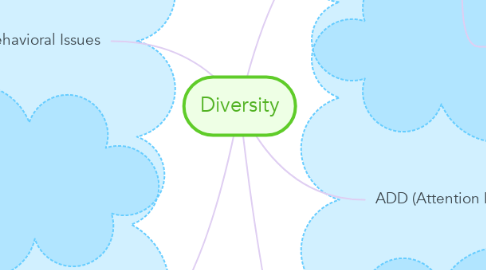
1. Emotional/Behavioral Issues
1.1. http://cecp.air.org/aft_nea.pdf
1.2. Behaviors observed: difficult to interact with others due to anxiety and fear, few or no friends, and may blame problems on others
1.3. Impact
1.4. Assessments Tools
1.4.1. Vision screening
1.4.2. interventions to address behavioral/emotional skill deficiency
1.4.3. Communication evaluation
1.5. Instructional Strategies
1.5.1. Development an active schedule for class
1.5.2. Keep activity instructions simple but structured
1.5.3. Using a separate testing setting when necessary
2. Giftedness
2.1. http://www.nsgt.org/giftedness-defined/
2.2. Behaviors observed: students are perfectionists, idealistic, and only accept A's- anything below is a failure.
2.3. Impact: independent thinker, advanced comprehension, and enjoys challenges by creative tasks
2.4. Assessments Tools
2.4.1. Achievement Tests - SATs
2.4.2. Ability Tests - Wescher Intelligence Scale for Children
2.4.3. Non-verbal Test -Matrix Analogies Test and Otis-Lennon
2.5. Instructional Strategies
2.5.1. Academic Competition
2.5.2. Utilizing the 3 upper section in Bloom's Taxonomy - analysis, synthesis, and evaluation
2.5.3. Use of technology
3. Austism
3.1. https://www.autismspeaks.org/family-services/resource-library/tools-professionals
3.2. Behaviors observed: interferes with reasoning, social interaction, and communication skills.
3.3. Impact: Challenges with non-verbal and verbal communication.
3.4. Assessments Tools
3.4.1. Childhood Autism Rating Scale
3.4.2. Autism Behavior Checklist
3.4.3. Real Life Rating Scale
3.5. Instructional Strategies
3.5.1. Develop visuals for instruction
3.5.2. Give the student choices and control
3.5.3. Limit distractions in the physical environment
4. ADD (Attention Deficit Disorder)
4.1. https://www.teachervision.com/add-and-adhd/resource/5348.html
4.2. Behaviors observed: Easily distracted, fidgiting, and disruptive behavior.
4.3. Impact: Can limit a students function to properly read and write.
4.4. Assessments Tools
4.4.1. Wechsler Adult Intelligence Scale Revise d
4.4.2. Classroom observations
4.4.3. Psychological evaluation
4.5. Instructional Strategies
4.5.1. Color-coded folders
4.5.2. Visual aids as reminders of subject material
4.5.3. Designate one teacher as the student’s advisor or coordinator
5. Specific Learning Disabilities
5.1. http://ldaamerica.org/educators/
5.2. Behaviors observed: short attention span,poor memory, difficult in following direction, and slower responses.
5.3. Impact: Difficulties understanding sequences in writing and performs poorly across most writing tasks, especially vocabulary, grammar, punctuation, and spelling
5.4. Assessments Tools
5.4.1. Responsiveness to intervention- interventions given by staff members
5.4.2. Curriculum based assessments-task and error analysis
5.4.3. Data from case history and observations
5.5. Instructional Strategies
5.5.1. Phonics
5.5.2. Vocabulary development
5.5.3. Reading comprehension strategies

